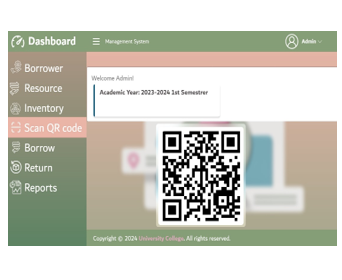Smart Educational Resource Management: A QR Code-Enabled System with Notification and Alerting Capabilities
DOI:
https://doi.org/10.69478/JITC2024v6n002a06Keywords:
Educational Resource Management, QR-code, Mobile Learning, Notification and Alerting, Smart EducationAbstract
Effective management of educational resources is crucial for ensuring the quality of learning outcomes. However, traditional systems often rely on manual processes, leading to inefficiencies, errors, and delays. This paper presents a novel QR Code-Enabled Educational Resource Management System that leverages Quick Response (QR) codes to streamline these processes. The proposed system uses QR codes to track the availability and location of resources such as textbooks and equipment. Students and teachers can scan these codes with mobile devices to access relevant information, including resource availability, location, and usage history. Additionally, the system features notifications and alerting capabilities that remind users when resources are due or inform them of changes in availability. The system was evaluated using the ISO/IEC 25010 Model Quality Characteristics Framework, which includes functional suitability, performance efficiency, compatibility, usability, reliability, portability, and maintainability. Results indicate high levels of quality in use, with excellent performance efficiency, security, compatibility, reliability, and maintainability. This study demonstrates the potential of the QR Code-Enabled Educational Resource Management System to enhance the effectiveness and efficiency of educational institutions. The system's notification and alerting capabilities can further improve student engagement and motivation by providing timely reminders and updates on resource availability.
References
G. N. Wikramanayake, “Impact of Digital Technology on Education,”, https://www.researchgate.net/publication/216361364.
J. Aliyu, S. Osman, J. A. Kumar, C. A. Talib, H. Jambari, “Students’ Engagement through Technology and Cooperative Learning: A Systematic Literature Review,” International Journal of Learning and Development, vol. 12, no. 3, July 2022, pp. 23-40, https://doi.org/10.5296/ijld.v12i3.20051.
H. T. Ekundayo, “Administering Secondary Schools in Nigeria for Quality Output in the 21st Century: The Principals Challenge,” European Journal Educational Studies, vol. 2, no. 3, 2010, pp. 187-190, https://doi.org/10.18767/EJES.93771.
Z. Assanova, S. Tileubay, N. Ibragimova, Z. Bissenbayeva, A. Zhakish, “Development of the Creative Potential of Future Teachers Based on Smart Education,” Scientific Herald of Uzhhorod University. Series “Physics”, vol. 2024, no. 55, March 2024, https://doi.org/10.54919/physics/55.2024.55ds3.
A. Haleem, M. Javaid, M. A. Qadri, R. Suman, “Understanding the Role of Digital Technologies in Education: A Review,” Journal of Education and Human Development, vol. 3, June 2022, pp. 275-285, https://doi.org/10.1016/j.susoc.2022.05.004
C. P. Akpan, “Resource management and Job Involvement among University Lecturers in South-South Nigeria,” European Journal of Business and Social Sciences, vol. 1, no. 8, November 2012, pp. 12-22.
A. F. M. Fauzi, N. N. Mohamed, H. Hashim, M. A. Saleh, “Development of web-based smart security door using QR code system,” in Proc. of 2020 IEEE International Conference on Automatic Control and Intelligent Systems (I2CACIS), June 20, 2020, Shah Alam, Malaysia, pp. 13-17, https://doi.org/10.1109/I2CACIS49202.2020.9140200.
A. Patel, A. Joseph, S. Survase, R. Nair, “Smart Student Attendance System Using QR Code,” in Proc. of 2nd International Conference on Advances in Science & Technology (ICAST) 2019, April 8-9, 2019, Mumbai, India, https://doi.org/10.2139/ssrn.3370769.
M. Imanullah, Y. Reswan, “Randomized QR-code Scanning for a Low-cost Secured Attendance System,” International Journal of Electrical and Computer Engineering, vol. 12, no. 4, August 2022, pp. 3762-3769, https://doi.org/10.11591/ijece.v12i4.pp3762-3769.
G. Durak, E. E. Ozkeskin, M. Ataizi, “QR codes in Education and Communication,” Turkish Online Journal of Distance Education, vol. 17, no. 2, April 2016, pp. 42-58, https://doi.org/10.17718/tojde.89156.
S. Kulkarni, S. Patil, S. Patil, K. Jayanti, “QR Code Attendance System with SMS Notification,” International Journal for Research in Applied Science & Engineering Technology, vol. 10, no. IX, September 2022, pp. 669-679, https://doi.org/10.22214/ijraset.2022.46701.
J. Rikala, M. Kankaanranta, “The Use of Quick Response Codes in the Classroom”, in Proc. of 11th Conference on Mobile and Contextual Learning, October 2012, https://ceur-ws.org/Vol-955/papers/paper_40.pdf.
M.H. Hashim, H. A. Jasim, “An Efficient Student Attendance Scheme Based On QR Code and Device Identifier,” in Proc. of Iraqi International Conference on Communication and Information Technologies (IICCIT), September 7-8, 2022, Basrah, Iraq, https://doi.org/10.1109/IICCIT55816.2022.10010338.
M. Rajendran, B. Kaur, “The Impact of Technology on Education,” ResearchGate, https://www.researchgate.net/publication/368637034_Impact_of_Technology_on_Education.
C. Law, S. So, “QR Codes in Education”, Journal of Educational Technology Development and Exchange, vol. 3, no. 1, October 2010, pp. 85-100, https://doi.org/10.18785/jetde.0301.07.
R. S. Mission, M. C. Saylo, “The Potential Use of QR Codes in u-Learning Systems”, Journal of Innovative Technology Convergence, vol. 1, no. 1, June 2019, pp. 1-10, https://doi.org/10.69478/JITC2019v1n1a01.

Downloads
Published
Issue
Section
Categories
License
Copyright (c) 2024 Lyrene Lamera Teves

This work is licensed under a Creative Commons Attribution-NonCommercial 4.0 International License.



